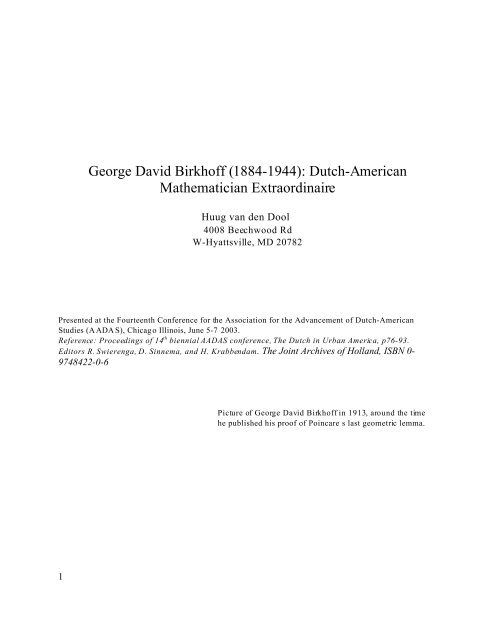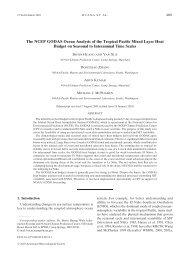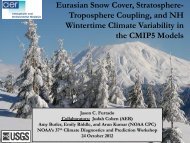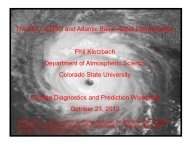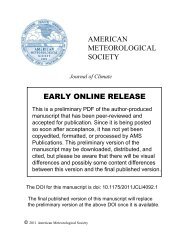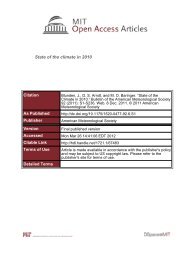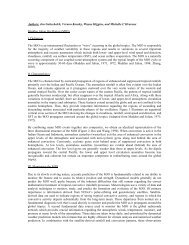George David Birkhoff (1884-1944): Dutch-American Mathematician ...
George David Birkhoff (1884-1944): Dutch-American Mathematician ...
George David Birkhoff (1884-1944): Dutch-American Mathematician ...
- No tags were found...
Create successful ePaper yourself
Turn your PDF publications into a flip-book with our unique Google optimized e-Paper software.
and this was the result of quiet, dedicated study. <strong>Birkhoff</strong> s first position was that of instructor atthe University of Wisconsin at Madison (1907-09). Next, he became a preceptor in mathematicsat Princeton University. In 1912 he accepted an assistant professorship at Harvard University,where he would work the rest of his life. He was promoted to professor in 1919 and was namedPerkins Professor in 1932. In 1936 he became the dean for the faculty of Arts and Sciences.Professionally, he served as vice-president of the <strong>American</strong> Mathematical Society (AMS) in1919, editor of the Transactions of the AMS from 1921 to 1924, AMS President in 1925-26, andPresident of the <strong>American</strong> Association for the Advancement of Science in 1937. This latterposition is rarely held by a mathematician. In 1940 <strong>Birkhoff</strong> was nominated President of theInternational Mathematical Congress.The list of honors <strong>Birkhoff</strong> received is too long to reproduce in detail. He received somefourteen honorary degrees, about five in the United States, and the rest abroad. He was elected tothe National Academy of Sciences in about a dozen countries. According to his biographers, heworked tirelessly (the expression used was with religious devotion ) to advance mathematics inthe United States. His loyalty to Harvard for so long was accompanied by countless visiting faculty positions throughout the world, mainly Europe, but also some in South America. 5<strong>Birkhoff</strong> wrote five books and nearly two hundred articles, mainly single-authored.Among his books is a bestseller in teaching, entitled Basic Geometry, which he co-authored withRalph Beatley. This highly recommended high-school text by two eminent scholars comes with amanual for teachers and an answer book. Despite his success as an author, comments on5The sources for the above are Marston Morse, G. D. <strong>Birkhoff</strong>, in Dictionary of Scientific Biography.,143-46 (1970, 1 980); Edward P . Wilson, G. D. <strong>Birkhoff</strong>, Obituary in Science, 102 (19 45): 578 -580; OswaldVeblen, <strong>George</strong> <strong>David</strong> B irkhoff , <strong>1884</strong>-<strong>1944</strong>, Proc.Amer.Phil.Soc., Yearbook 1946, p p279-2 85; re-pub lished in2001 as Biographical Memoirs, 80 by National Academy of Scineces and an excellent living document web pagemaintained at the School of Mathematics in Scotland is athttp://www-groups.dcs.st-and .ac.uk/~history/Mathem aticians/<strong>Birkhoff</strong>.html.5
<strong>Birkhoff</strong> s teaching skills were varied and guarded, in sharp contrast to his son, Garrett <strong>Birkhoff</strong>,who was very patient, well prepared, and focused while teaching mathematics at Harvard.<strong>Birkhoff</strong> as <strong>Mathematician</strong><strong>Birkhoff</strong> worked on a variety of different mathematical topics, ultimately applyinghimself to problems far afield. The subject of his main contributions is a question that appears tobe answered differently as time goes on. My comments are partly motivated by my ownbackground in atmospheric science, and by the sudden fame that <strong>Birkhoff</strong> obtained when chaostheory was discovered some twenty years ago. This is the only reason I even know about<strong>Birkhoff</strong>. (I did not realize instantly that <strong>Birkhoff</strong> was <strong>Dutch</strong>-<strong>American</strong>, because the namesounds German.)Poincaré theorem. Some of the great mathematicians, including <strong>David</strong> Hilbert and Poincaré leftfor the next generation a list of problems they considered important and as yet unsolved. Young<strong>Birkhoff</strong> became instantly famous all over the world when in 1913 he proved Poincaré s lastgeometric lemma to the satisfaction of a critical audience. This must have been a boy s dreamcome true, to prove something that had been too difficult for the great master. The theorem hadto do with fixed points, one of the classical topics in mathematics, for a torus being foldedonto itself.Ergodic theorem <strong>Birkhoff</strong> is best known for what is called the ergodic theorem. In a physicalsetting this means that one can learn about the governing process by measuring at one point for along enough time, as opposed to having to measure everywhere (which is impossible anyway).The full scope may be difficult to explain, but he worked this out for the gas laws, known fromancient laboratory experiments, and connected them to more modern molecular theory. In theprocess he outdid many physicists who had struggled to make this connection formally. This istypical for <strong>Birkhoff</strong> s work. He made excursions into unfamiliar fields, seemingly without effort,and almost immediately appeared at the leading edge of these sciences. While doing this he6
emained somewhat of an outsider in these applied fields, in part because he appeared to havethe red pencil ready for anybody who did not meet the highest standards of mathematical acuity.The four color problem. In the mid-nineteenth century a map-making clerk in Englanddiscovered that he could color any map in such a way that no two counties that shared a commonborder had the same color, if the map was colored with just four colors and no more. Why four?Would this be true for any imaginable configuration of counties? He could not find any counterexamples, nor has anyone else since. So certain statements are empirically true, but can we provethem? Ever since, this has been a central problem in mathematics. Even today no solid proofexists, although many tried and occasionally a proof is presented that survives the relentlesscritique of the colleagues for a short while.<strong>Birkhoff</strong> was attracted to this kind of problem. Although he did not solve it, he guidedfuture attempts to prove the four-color problem by developing the idea of reducibility . Becausewe cannot consider explicitly an infinity of possibilities, <strong>Birkhoff</strong> showed how a certain set ofproblems for n counties can be reduced to another set of problems for n-1 counties. And so on ton-2, n-3 etc. If one can prove the lemma for a low value of n, everything else follows byinduction. This principle is still used heavily. In 1976 two mathematicians reasoned that allpossible maps can be reduced to about forty nine different types of configurations. They thenused a computer to check all possibilities within these forty nine basic cases. The proof wasrejected, in part because the use of computers--to check all possibilities by brute force--defies thestandards for beauty of mathematical proof. More recent proofs still stand until further notice.Beauty, aesthetics and harmony <strong>Mathematician</strong>s are often obsessed with beauty and theaesthetics of mathematical abstraction. Mathematical proof is beautiful if it is as short, astransparent and as thought provoking as possible. 6 If you have not done something in thesimplest possible way, you have not really understood the problem at all. Usually this type of6J.P. Van Bendegem, Schoonheid in de wiskunde (Beauty in Math): <strong>Birkhoff</strong> revisited," Tijdschrift voor Filosofie60 (No.1, 1998): 106-30.7
thought among mathematicians applies strictly to math itself, such as simple and transparentproof, but in <strong>Birkhoff</strong> s case he wondered about the beauty of objects of art, music, poetry etc.Why is it that people think something is beautiful or ugly?. Some of the pure math actuallyinvolves words like harmony , tones, overtones, sub-harmonics. He even took a year off to visitmuseums around the world so as to prepare himself thoroughly for a mathematician s view ofaesthetics. His work on a quantitative measure for aesthetics is unique if for no other reason thatnearly no one else has attempted a mathematical view of these subjects. And he even went on toethics!Relativity theory In 1921 <strong>Birkhoff</strong> taught a course at Harvard in relativity, a modern topic inphysics which was in the lime-light (Einstein got the Nobel Prize that year, albeit for a differenttopic). Although the topic must have been new to <strong>Birkhoff</strong> (except for Poincaré writings on thematter), he was not intimidated by relativity, nor daunted by its complexity. Quite the contrary,he immediately tried to improve upon Einstein s mathematical approach, and for decades, waspersistently vocal about the errors Einstein had allegedly made. In this respect he was like othermathematicians such as Hilbert who had stated that physics is too difficult to be left to thephysicists.<strong>Birkhoff</strong> published a much-quoted article on relativity in 1923. At stake were the correcttransformations one has to make from curved space to rectangular coordinates. In the extremethis work applies to gravitational collapse, which much later found application in astronomicalblack holes. In the history of developing ideas about black holes, <strong>Birkhoff</strong> still gets prominentmention today.Dynamical systems. In 1927 <strong>Birkhoff</strong> published his famous textbook on Dynamical Systems. Itwas republished several times. This work, more than any other, is building on Poincaré s ideas.The origin of these ideas lies in the motion of the heavenly bodies: the moon, earth, sun, planets,and how one explains their orbits. But the same equations apply to fluids. <strong>Mathematician</strong>s excelin simplifying these problems to just two or three bodies and then they explore every aspect of8
theory under any imaginable circumstance. The greatest minds (Pierre-Simon Laplace!) hadworked on this. <strong>Birkhoff</strong> was much impressed, in general, by classical problems. Systems withtwo and three degrees of freedom are the main topic in <strong>Birkhoff</strong> s book. Classically, theemphasis was on regular, self repeating and predictable solutions, like planets in an orbit. Manybefore <strong>Birkhoff</strong>, including Poincaré, shied away from non-periodic or somewhat irregular orstrange and unpredictable solutions. But <strong>Birkhoff</strong> made note of this. Subsequently, his work onthese irregularities was forgotten for fifty years and waiting for something to happen.Chaos, weather and strange attractorsIn review articles on atmospheric science one can nowadays read about <strong>Birkhoff</strong>. 7 This israther stunning since <strong>Birkhoff</strong> never worked in this field. The way this came about is thatProfessor Edward Lorenz of the Meteorology Department at the Massachusetts Institute ofTechnology discovered by accident that when one calculates twice via computer a weatherforecast from very slightly different initial conditions, the results can be very far apart after afew weeks. This characteristic of many natural systems is now called the limit of predictability resulting from sensitivity to details in the initial state. The flap of the wings of a butterflyprevents perfect weather forecasts.In 1963 Lorenz showed that such behavior (a lack of predictability) already exists whenhe simplified the equations for weather forecasting to only three degrees of freedom. It tookanother fifteen years before a new generation of mathematicians took note of Lorenz s paper anddeveloped the math for what is now called chaos. Upon further reflection, Lorenz came to theconclusion that the lectures given by <strong>Birkhoff</strong>, which Lorenz attended when he was a student inMathematics at Harvard in the early 1940s, may have guided him in the correct analysis of his1963 results, which anyone else might have thought of as a programming error. Reproducingone s results, suddenly, was no longer obvious!7 W. Lablans , De visie van E d Lorenz op d e voorspelbaarh eid van het w eer, Meteorologica 10 (No. 2, 2001): 25-31. F. Verhulst, Dehistorische route n aar chaos , De vlinder van Lorenz (ISBN 906834064 6;1990), edited by H. Tennekes, 15-33.9
Textbooks on chaos theory now draw a line from Poincaré, via <strong>Birkhoff</strong> and Lorenz, tocurrent mathematical experts. And as it turns out, a new discovery by <strong>David</strong> Ruelle and FlorisTakens around 1980, the strange attractor, was not that new after all. <strong>Birkhoff</strong> is now creditedfor having displayed the first strange attractor. The way that chaos became a new science is along story. 8 This type of fame could be temporary, of course; one hundred years from nowscientists may exclude mention of anybody we now think of as famous. But for the time being,<strong>Birkhoff</strong> is famous in chaos theory, although, curiously, he would not know what we mean bythe term today.<strong>Birkhoff</strong> s FameUntil 1900 any self-respecting <strong>American</strong> mathematician or scientist would seek hiseducation, or at least part of it, abroad, typically in Europe. The general assumption was that theUnited States was a backwater in the fields of science and mathematics. <strong>Birkhoff</strong> did not studyabroad and we do not know why. Because of his exceptional talent, he was living proof thatsince about 1910, mathematicians with education in America only could in fact make it to thetop of international recognition.Later on many people abroad simply assumed that <strong>Birkhoff</strong> had studied in France andwas a student out of Poincaré s school - <strong>Birkhoff</strong> has also been called America s Poincaré.Some scientists, writers, or artists become famous for their work later in their lives or even afterthey die, after having struggled all their lives with little attention or a place at the table ofintellectual recognition. Not <strong>Birkhoff</strong>. He became famous very early on; he won easy recognitionand climbed a career ladder to remarkable heights. This was not a struggling genius that lackedrecognition during his own lifetime. It is amazing what he achieved in a short life.As late as the first half of the twentieth century, scientists felt they had to cover a widescale of sciences. They were philosophers, mathematicians, and physicists, all at the same time.So while <strong>Birkhoff</strong> is clearly a mathematician, he paid attention to many other fields, and was8James Gleick, Chaos: Making a New Science. (New York: Viking Penguin, 1987).10
eager for a chance to make a contribution later in his career. Ultimately, he published onastronomy, gravity, relativity theory, and philosophical topics like beauty, which he tried tounderstand in terms of basic notions that came naturally to him as a mathematician. It is not yetclear whether any of his work outside mathematics is of enduring significance.However, the most audacious foray <strong>Birkhoff</strong> made outside mathematics was to redo thetheory of relativity. <strong>Mathematician</strong>s are obsessed with simplicity and elegance. If it is not doneas simply as possible, one has failed in the eyes of peers. <strong>Birkhoff</strong> felt that way about Einstein smost famous work, particularly the use of curved coordinates, which was much criticized.<strong>Birkhoff</strong> essentially held the position that Einstein s theory of general relativity was less thanhelpful . To take on an icon like Einstein is a sign of great confidence on the part of <strong>Birkhoff</strong>, orwas it simply egotistical foolishness? Possibly <strong>Birkhoff</strong> inherited an attitude from Poincaréwho also held the point of view that Einstein was given too much credit.<strong>Birkhoff</strong> ApellationsThe name <strong>Birkhoff</strong> is connected to various scientific ideas and awards. A select list includes:<strong>Birkhoff</strong> s Bagel. This is a catchy phrase to describe the first ever published strangeattractor. This reference made the concept tangible, much like Lorenz s butterfly. 9<strong>Birkhoff</strong> s Crater. <strong>Birkhoff</strong> made contributions to astronomy that have been honored by naminga crater on the moon after him. Who could have imagined a <strong>Dutch</strong> <strong>American</strong> crater on the moon!<strong>Birkhoff</strong> s Billiard. <strong>Mathematician</strong>s love well-posed but, as it often turns out, non-trivialproblems. Among them the 2 or 3 or n body problems. Originally an astronomical problem,how do n heavenly bodies (like sun, planets, moons) move in space while attracting each otherby gravity, but simplified to, for instance, the predictability of the position and speed of billiardballs on a table with certain properties.<strong>Birkhoff</strong> Prize . Actually there are two, if not three, such prizes. The most famous is an<strong>American</strong> Mathematical Society award, a <strong>Birkhoff</strong> Award, established in 1967, currently $4000,9See also Gleick .11
awarded once every five years for original work in applied mathematics. The first money camefrom the <strong>Birkhoff</strong> family. Remarkably, one of the awardees in 1978 was <strong>Birkhoff</strong> s son, Garrett<strong>Birkhoff</strong>, himself a well known Harvard mathematician.<strong>Birkhoff</strong> Essay. This is a writing award for students at Hope College in Holland, Michigan,which is awarded with a small monetary recognition, currently $75. The prize was established by<strong>George</strong> <strong>Birkhoff</strong>, Jr., in 1888. Initially, the essay had to be written in <strong>Dutch</strong>, then there was aperiod with two parallel <strong>Birkhoff</strong> essay prizes, one in <strong>Dutch</strong> and one in English. From 1914 on,English was the only language used. <strong>George</strong> <strong>Birkhoff</strong>, Jr., is said to have been a benefactor ofthe College.<strong>David</strong> <strong>Birkhoff</strong> Window. A sign that charity was common in the <strong>Birkhoff</strong> family isdemonstrated by a stained glass window (named <strong>David</strong> ) in Hope Church in Holland,Michigan, donated by Mrs Louise <strong>Birkhoff</strong> Boers and family in 1924.<strong>Birkhoff</strong> Aesthestics. The name <strong>Birkhoff</strong> is connected, like almost no other, to beauty andesthetics in mathematics and science. His equation describing the competing impact of order andcomplexity is applied to just about everything. I even found an attempt to analyze NationalHockey League games in terms of what the public likes and why, following <strong>Birkhoff</strong> s estheticmeasures.A search on the Internet gives several more examples, such as the <strong>Birkhoff</strong> polytope,<strong>Birkhoff</strong> normal form, <strong>Birkhoff</strong>-von Neumann crossbar switches, <strong>Birkhoff</strong> interpolation (thetitle of a book published in 1985), <strong>Birkhoff</strong> theorem, <strong>Birkhoff</strong> rule, <strong>Birkhoff</strong> s house inCambridge (a national landmark), <strong>Birkhoff</strong>-Roth equation, sub-<strong>Birkhoff</strong> logical equation,Poincaré-<strong>Birkhoff</strong>-Witt theorem, <strong>Birkhoff</strong> Mathematical Library at Harvard, Poincaré-<strong>Birkhoff</strong>fixed point theorem, <strong>Birkhoff</strong> bifurcation, <strong>Birkhoff</strong> effect, etc. Some of these expressions mayrefer to Garrett or someone else still, but the majority refer to <strong>George</strong> <strong>David</strong> <strong>Birkhoff</strong>.Conclusion12
The life and career of the famous <strong>Dutch</strong>-<strong>American</strong> mathematician, <strong>George</strong> <strong>David</strong><strong>Birkhoff</strong>, was distinguished and astoundingly different from his countrymen who becamefarmers and small merchants, or even professors at small, church-affiliated colleges that aremore typical of the <strong>Dutch</strong> immigrants and their descendents. Unlike many second-generationHollanders, he adapted readily to America. His family s status and wealth certainly enabled himto study and follow scientific pursuits, instead of working on the truck or tending a store. He hadan excellent mind for mathematics and science and got the best education his era had to offer. Healso learned much from reading books, especially those by the prolific Poincaré. <strong>Birkhoff</strong> wrotehis master's thesis quite independently. He was a nationalist in that he was religiouslydedicated to promoting mathematics in the United States, and he witnessed the period in whichmathematics in the US rose from obscurity to a world-class and respected profession. Hepersonally rose to the forefront like no other, was recognized and awarded as a towering figureearly in life, and assumed enormous power in academia. He was also a great internationalist withclose connections all over the world. <strong>Birkhoff</strong> was not a closet mathematician working alone onesoteric theories. His biographers note that he was very social and not at all eccentric , which is,apparently, unusual for a genius. Much of his work remains relevant today decades after hisdeath. One of his biographies has recently been republished by the National Academy ofSciences.Where is the <strong>Dutch</strong>-<strong>American</strong> connection? Other than the name and the roots, there islittle <strong>Dutch</strong> about <strong>Birkhoff</strong>. Without his grandfather s booklet we would have had little to sayspecifically about any <strong>Dutch</strong> or <strong>Dutch</strong>-<strong>American</strong> heritage. While his father and uncles were veryaccomplished also, they operated mainly among <strong>Dutch</strong>-<strong>American</strong>s. It appears <strong>Birkhoff</strong> did notlook back after he got started as an academic. He wrote his scientific articles in many languages,notably French, German, Spanish and, of course, English. Curiously, we have not found anypapers in <strong>Dutch</strong>, although we assume <strong>Dutch</strong> was his mother tongue. Had his parents stayedlonger in rural Michigan, his schooling would have started in <strong>Dutch</strong>. There were <strong>Dutch</strong> schools13
in Chicago, but they were affiliated with the conservative Christian Reformed Church, a <strong>Dutch</strong>Reformed splinter body that the <strong>Birkhoff</strong>s eschewed; they belonged to the Reformed Church inAmerica, the nation s oldest Protestant body, whose youth attended public schools. Nor is thereany evidence or particular interest in anything <strong>Dutch</strong> or even of <strong>Dutch</strong> mathematicians. Therewere only several co-workers, Harry S. Vandiver (Princeton) and Edward Burr van Vleck(University of Wisconsin) with roots in colonial New Netherlands. Among his students was B.O. Koopman, the famous statistician. His contacts in Europe were most often followers ofPoincaré. There are references in <strong>Birkhoff</strong>'s work to L.E.J. Brouwer, his Netherlandiccontemporary and a man considered the father of intuitive mathematics. But there is certainly noclannishness in these references. Even <strong>Birkhoff</strong>'s writings about faith, beauty, freedom, and themathematics of the good, contain no direct references to his upbringing in the <strong>Dutch</strong> ReformedChurch. His marriage to Margaret Grafius also reveals a significant break with traditional <strong>Dutch</strong>Reformed life. One small story would note some interest by the mathematics department of theUniversity of Amsterdam to bring <strong>Birkhoff</strong> in, probably in the 1920s. The real star in thatdepartment was Brouwer. <strong>Birkhoff</strong> may have entertained the idea of living in the Netherlands,but nothing came of it.While writing a biography, even a short one, several questions haunt the author. Wouldthe subject approve of what is written? Should the subject be considered a hero? Most of whatwe write paints <strong>Birkhoff</strong> as a great man. Perhaps as an antidote, let me note that <strong>Birkhoff</strong> wasnot uniformly popular, as we might expect. There were the normal rivalries and tensions amongscientists with competitive and domineering egos. One biographer notes that his social/politicalviews were detached from the world , an occasional source of misunderstanding. The web sitemaintained by the Mathematics Department of St. Andrews University in Scotland has justrecently added a paragraph to the <strong>Birkhoff</strong> page noting a negative side of his character. <strong>Birkhoff</strong> (and 2 or 3 others) had such power that they had a virtual veto over every appointmentin academic mathematics in the United States. In 1933 Einstein came to America. Sensing that14
his European Jewish colleagues were in grave danger, Einstein tried to find jobs for his Europeancolleagues. Apparently <strong>Birkhoff</strong> and some colleagues, who were looking after the prospects oftheir own students, were not enthusiastic to free up opportunities for these particular immigrants,quite possibly at the expense of qualified <strong>American</strong>s. This reluctance induced Einstein, who mayalso have been irritated by <strong>Birkhoff</strong> s persistent professional criticism, to make a stronglywordedaccusation of anti-Semitism against the <strong>Birkhoff</strong> group.A full-length biography of <strong>George</strong> <strong>David</strong> <strong>Birkhoff</strong> is needed, beginning with the plethoraof information in the extended obituaries and summaries of his work for encyclopedias by someten different authors. This task awaits a mathematician with an interest in the history of thediscipline. A thorough study of the <strong>Birkhoff</strong> archive, including private correspondence, is neededto complete the picture of his transition from <strong>Dutch</strong> ethnic to <strong>American</strong> scientist. The biographywould also address <strong>Birkhoff</strong> s brand of nationalism and attitudes towards certain immigrants.In spite of his nationalism <strong>Birkhoff</strong> was an internationalist, par excellence. (So much forcontradictions.) He traveled frequently and knew colleagues everywhere on the planet. He was avisiting faculty and member of the National Academy of more than ten nations. Given his statusand his international outlook, he was asked by the Rockefeller Education Institute to write areport on the status of mathematics in Europe in 1926. <strong>Birkhoff</strong> used the occasion to make theUnited States look quite good compared to Europe, which to be sure, was largely his ownaccomplishment. Times had changed, and tables had turned.Clearly, this man with common roots rose far above any clan or tribal ties. He was not ahyphenated <strong>American</strong> at a time during the First World War when there was considerablepressure to be <strong>American</strong> and to suppress ones ethnic heritage. <strong>Birkhoff</strong> would have been a starin his field regardless of where he was born, given the right opportunities and at least minimalencouragement. Even Overisel, Michigan would do. Use of a search engine in 2002 revealsforty-seven mentions of Overisel on the Internet in connection with <strong>Birkhoff</strong>. We do not know15
whether <strong>Birkhoff</strong> had any sentimental feelings towards the place where he was born, but he is,undoubtedly, Overisel s most famous son.Appendix: A few background notes on the <strong>Birkhoff</strong> and Droppers familyFor both the Birkho ff and Droppers families we consulted the usual official sources, i.e. migration lists,Census, Burgerlijke Stand etc. An extensive genealogy has been worked out for Droppers, along with most otheremigrants from Winterswijk on a webpage out of the University of Twente. There is no formal genealogy for<strong>Birkhoff</strong>, as far as we can tell, but there is a most interesting write-up b y <strong>George</strong> Sr about the family (Birkho ff1910), back to 1650. And a good number of references to various <strong>Birkhoff</strong>s of note can be found in the literature,such as in van Hinte(1985) and Swierenga(2002). Here we summarize the information on the paternal and maternalfamily of <strong>George</strong> <strong>David</strong> <strong>Birkhoff</strong> from the moment they came to the US.Greatgrandfather Garrit Jan Droppers, born Winterswijk 3 Jan 1792, emigrated from Winterswijk,Gelderland to Milwaukee, WI, USA in 1847, with his wife Janna Geertruid Vardink and 8 children. Garrit Jan wasone of several Droppers who came from Winterswijk to the US, probably all closely connected relatives and havingmany duplicate first names. They were Gereformeerd according to the emigration lists (Swierenga 1983) which weassume means Afgescheiden. The Droppers were a confectioners family in Winterswijk, a profession they continuedin Milwaukee. The p rogenitor G arrit Jan died 2 March1860. His son Jan Derk Droppers, born W interswijk July,24,1832, married in the US to Geertruida Boeijink, one year younger, (she died in 1880), who also had aWinterswijk background. Jan Derk and Geertruida had ten children, one of which was Janna Geertruida D roppers,mother of G D, born 8 March 1862 in Milwaukee. The reference for the above ishttp://www.twente.nl/~genealogy/emigration/winterswijk_emigrants.htm where material of some 25,000 p eople isdeveloped. Janna Geertruida Droppers was renamed Jennie (or Jane) later in life. On his mother s side GD thus hadgreat-grandparents in this co untry.According to the emigration lists (Swierenga 1983) Gerrit <strong>Birkhoff</strong> (b Ooltgensplaat Zuid Holland 9 Sept1827) emigrated fro m Rotterd am to the U S in 1869 with his wife Agatha van Putten, and seven children (all bo rn inOoltgensplaat) with the stated destination of Chicago Illinois. Indeed, the 1870 Census (Swierenga 1987) shows thefamily with somewhat adjusted names (and unavoidable spelling errors) in Cook County, Chicago Township,Illinois. The children, Ruth Geris, Maatje, <strong>David</strong>, Willemina, Lijntje, Klaas and Cornelia (original names!) rangedfrom age 17 to 4 years old. The family had been fairly prosperous before, but when Gerrit took over the businessfrom his deceased father in 1845 o r so, a series of m ishaps created much p overty. Also his private life was difficult.In desperation they made the radical choice of emigration. The beginnings in the US were very difficult. None ofthem knew a word of English. But within a few years they were back on their feet and quite wealthy. The conversionfrom Gerrit to <strong>George</strong> between 1870 and 188 0 Census is worth noting. T he oldest two sons, Geo rge jr and D avidwould be well known in Chicago. Van Hinte(1985) gives high praise when he writes about <strong>George</strong> Sr.: He becamea man of great standing...and was an hono rary memb er of the Chicago Carp enters and B uilders Union .In the 1900 Census we find <strong>David</strong> <strong>Birkhoff</strong>, 43 years old, a physician, lives at 408 M arshfield Ave inChicago, with his wife Jennie, and 6 children: <strong>George</strong> D (16), Louise M (14), John (12), <strong>David</strong> (8), Gertrude (6) andEdward R (1). The older two are born in Michigan, the rest in Illinois. One more child, Jeanne, was born later.<strong>Birkhoff</strong> (1910) had high praise for all his children, but he ran nearly out of superlatives when he describeshis oldest son, <strong>George</strong> Jr. Basically, this boy developed overnight into a first class businessman. Soon he was a realestate broker at one of the largest firms in Chicago. He was elected director and president of the local real estateboard , and became the promoter of the Holland Building and Loan A ssociation. H is fame grew further when, in1886, K ing Willem III of The N etherlands appointed him Consul of The N etherlands for five states in the US, aposition he kept for almo st 30 years. M ore can be found on <strong>George</strong> jr in Krabb endam(2 003, see this volume).<strong>Birkhoff</strong> (1910) states that <strong>David</strong> was extremely talented in many disciplines, including calculus, but that itwas decided after lengthy deliberations that he should become a doctor. <strong>David</strong> finished his education at RushMedical College in Chicago. According to his father he was the first Hollander to graduate from this great medicalschool. He landed his first job in Oostburg, Wisconsin, another <strong>Dutch</strong> enclave. He did well professionally, and,16
equally important, he found his future wife, Janna Geertruida Droppers, in nearby Milwaukee - they married in 1883.<strong>David</strong> moved on quickly to another som ewhat larger medical practice he bought in Overisel, M I. The two oldestchildren of D avid and Jennie were b orn in Overisel. But somehow Chicago remained a magnet for the now urbanite<strong>Birkhoff</strong>s, and <strong>David</strong> returned to the city in 1886 (Grondwet 1886). <strong>David</strong> became president of the West SideDoctors Association and was known for brilliant lectures. Unfortunately, <strong>David</strong> had a poor health and died in 1908at the age of only 52.References:Anonymous, 1886: Article in De Grondwet, May 15, 1886.<strong>Birkhoff</strong>, <strong>George</strong> Sr., 1910: A short history of The Family <strong>Birkhoff</strong>. 64 pages. Published privately. Available fromHerrick Library in Holland Michigan.Swierenga R. P., 1983: <strong>Dutch</strong> emigrants to the United States, South Africa, South America and Southeast Asia,1835-1880: an alphabetical listing by household heads and independent persons. Scholarly Resou rces,Wilmington Delaware.Swierenga, R. P., 1987: <strong>Dutch</strong> households in US population censuses, 1850, 1860, 1870: An alphabetical listing byhousehold heads.Swierenga, R. P., 2002: <strong>Dutch</strong> Chicago. A history of the Ho llanders in the Windy City. 908 pages. Wm. Eerdm ans,Publishing Co, Grand Rapids/Cambridge.Hinte, J. van , 1928: Nederlanders in A merika. P . Noordh off, Groningen. A new edition in English appeared in1985, edited by R. P. Swierenga.17


